Experience Tranquility: How Visiting Guangxiao Temple Can Enrich Your Spiritual Journey
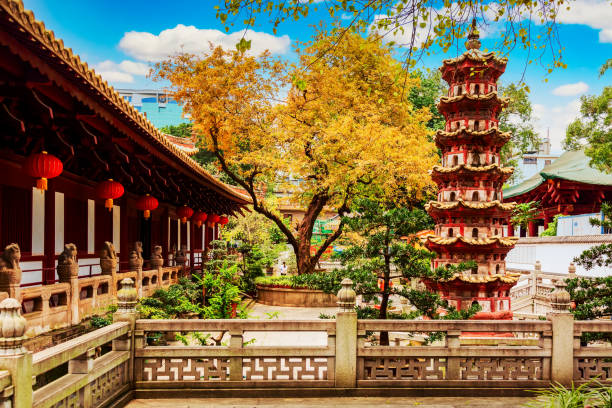
An Essential Guide to Visiting Guangxiao Temple
Nestled in the heart of Guangzhou, Guangxiao Temple (光孝寺) stands as a magnificent testament to over 2,000 years of history and spirituality, drawing visitors from around the globe. What sets this temple apart is not just its stunning architecture or serene atmosphere; it is home to a bodhi tree believed to have been planted by the revered Sixth Patriarch Huineng himself, making it a living symbol of enlightenment and devotion. Each year, hundreds of thousands of devotees and curious travelers alike flock to this sacred space to seek blessings, meditate, and immerse themselves in the rich tapestry of Lingnan culture.
In this essential guide, you will discover the temple’s storied past, explore its main attractions—from the awe-inspiring Mahavira Hall to the spiritually significant Hair-Burial Pagoda—and navigate practical visitor information, including ticket prices and opening hours. You’ll also find a recommended walking route to ensure you experience every corner of this historical gem, along with tips for nearby dining options and accommodation. Whether you’re seeking spiritual solace or a deeper understanding of Chinese heritage, Guangxiao Temple offers an enchanting escape that promises to leave a lasting impression. Let’s embark on this enlightening journey together!
In This Guide
- An Essential Guide to Visiting Guangxiao Temple
- The Rich History and Legends of Guangxiao Temple
- Main Highlights: What You Absolutely Can’t Miss
- Planning Your Visit: A Practical Guide
- Tickets: Prices, Booking, and Tips
- How to Get There: A Complete Transportation Guide
- Local Cuisine and Accommodation Nearby
- Frequently Asked Questions
- Final Thoughts on Your Trip
The Rich History and Legends of Guangxiao Temple
A Journey Through Time: The History of Guangxiao Temple
Guangxiao Temple, steeped in over 2,000 years of history, serves as a remarkable testament to the evolution of Buddhist culture in southern China. From its origins as a royal residence to its present status as a major spiritual site, the temple’s past is rich with stories of devotion, transformation, and legendary events.
The Early Beginnings: A Royal Residence
Dating back to the 2nd century BCE, Guangxiao Temple began as the residence of Zhao Jiande, the King of Nanyue. This early incarnation laid the groundwork for what would later become a sacred site for Buddhists. The temple’s prominence grew during the Three Kingdoms period when the renowned scholar Yu Fan transformed the area into a private garden known as “Yu Garden.” This marked the beginning of its transformation into a spiritual haven.
The Rise of Buddhism: A Sacred Transformation
As Buddhism gradually spread across China, Guangxiao Temple evolved from a royal retreat into a significant religious site. During the Eastern Jin dynasty, the temple was expanded and renovated, giving rise to its impressive architectural layout. The construction of the Mahavira Hall, housing the revered Shakyamuni Buddha, solidified the temple’s status as a center of Buddhist worship.
The Legendary Bodhidharma and the Bowl-Washing Spring
One of the most intriguing legends associated with Guangxiao Temple involves Bodhidharma, the legendary monk credited with bringing Zen Buddhism to China. It is said that he carved the Bowl-Washing Spring during the Southern Dynasties period. This spring has since become a symbol of purity and enlightenment, attracting pilgrims who seek its waters for spiritual nourishment.
The Tang Dynasty: A Flourishing Spiritual Hub
The Tang dynasty (618–907) marked a period of expansion and prosperity for Guangxiao Temple. The Hair-Burial Pagoda, a significant structure within the complex, became a focal point for many devotees. According to legend, the pagoda honors disciples who buried their hair here as a commitment to renouncing worldly ties. This act of devotion continues to resonate with visitors, who engage in rituals around the pagoda to seek spiritual purification.
The Six Patriarch and the Legacy of Huineng
As time progressed, Guangxiao Temple became closely associated with the teachings of Huineng, the Sixth Patriarch of Zen Buddhism. A bodhi tree, believed to have been planted by Huineng himself, still thrives on the temple grounds, drawing countless worshippers who come to pay their respects. The tree symbolizes wisdom and enlightenment, echoing Huineng’s teachings and the spirit of Zen.
The Song and Ming Dynasties: Architectural Splendor
Throughout the Song (960–1279) and Ming (1368–1644) dynasties, Guangxiao Temple witnessed further architectural enhancements, including the construction of the Iron Pagoda of a Thousand Buddhas and the Reclining Buddha Hall. These structures not only reflect the intricate artistry of the time but also serve as enduring symbols of the temple’s cultural and spiritual significance.
The Modern Era: A Living Legacy
Today, Guangxiao Temple stands as a living testament to the rich tapestry of Lingnan history and Buddhist culture. With over 500,000 visitors annually, it continues to attract those seeking spiritual solace amidst the hustle and bustle of modern life. The temple remains a vibrant sanctuary where ancient legends and contemporary devotion intertwine, offering a unique insight into the enduring nature of faith and tradition.
Conclusion
From its royal origins to its present-day status as a revered spiritual site, Guangxiao Temple encapsulates the essence of Guangzhou’s rich history. Its legends and historical milestones invite travelers to not only witness the beauty of the temple but to also partake in the timeless stories that breathe life into its ancient walls. Whether you seek spiritual enlightenment or a glimpse into the past, Guangxiao Temple promises a profound journey through history and legend.
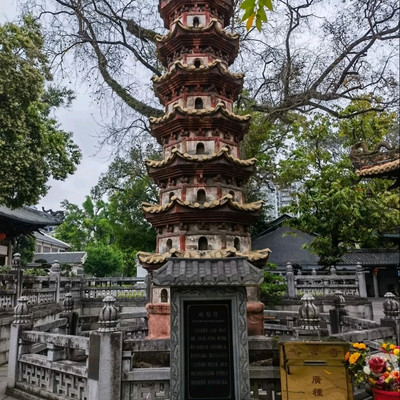
Guangxiao Temple.
Main Highlights: What You Absolutely Can’t Miss
Hall of Heavenly Kings
As you step through the entrance of Guangxiao Temple, the Hall of Heavenly Kings welcomes you with its grand presence. This monumental structure serves as a gateway to the temple’s serene atmosphere. Inside, the central figure of the Maitreya Buddha radiates joy and acceptance with his open arms and round belly. Flanking him are the Four Heavenly Kings, each holding unique symbolic objects that embody protection and balance. Tip: Spend a moment in contemplation, perhaps lighting incense as you pray for family harmony or good health. This hall is a favored spot for blessings related to domestic well-being.
Mahavira Hall (Main Hall)
The Mahavira Hall is truly the spiritual heart of Guangxiao Temple. Here, the majestic Shakyamuni Buddha presides over the space, flanked by the revered Bodhisattvas Manjusri and Samantabhadra, along with the compassionate Guanyin. Together, they embody wisdom, virtuous practice, and boundless compassion. Tip: Many visitors come to pray for success in their careers or academic pursuits. Take a moment to soak in the atmosphere, as the air is thick with the scent of incense—each bow and prayer is a step toward manifesting your heartfelt wishes.
Hair-Burial Pagoda
Adding a layer of mystique to your visit, the Hair-Burial Pagoda is steeped in spiritual significance. Legend has it that this pagoda honors disciples who buried their hair here as a vow to renounce worldly ties. Visitors often engage in a ritual of bowing before the pagoda and walking around it an odd number of times, which symbolizes spiritual purification. Tip: Approach this practice with intention—this sacred act connects you to the deeper teachings of Buddhism and offers a moment of reflection.
Bowl-Washing Spring
Nestled within the temple grounds, the Bowl-Washing Spring is a serene and lesser-known gem. According to legend, this spring was carved by Bodhidharma during the Southern Dynasties and symbolizes the cleansing of the mind. The tranquil sound of water adds to the peaceful ambiance of the temple. Tip: Take a moment to sit by the spring and meditate, allowing the gentle flow of water to wash away any stress or distractions. It’s an ideal spot for quiet contemplation.
Iron Pagoda of a Thousand Buddhas
This remarkable structure, dating back to the Southern Han dynasty, is adorned with intricate carvings and embodies the rich artistic heritage of the temple. The Iron Pagoda houses numerous small Buddha statues, each representing a different aspect of Buddhist teachings. Tip: Pay close attention to the details in the carvings, as they tell stories of devotion and history. This is a perfect spot for photography, so don’t forget to capture the beauty of this architectural marvel!
Six Patriarch Hall
Delve deeper into the teachings of Zen Buddhism at the Six Patriarch Hall, dedicated to Huineng, the Sixth Patriarch. The hall serves as a space for reflection on the Zen principles of enlightenment and mindfulness. Tip: If you can, join a meditation session here. It’s an excellent opportunity to experience the tranquil atmosphere and gain insights into the essence of Zen philosophy.
Reclining Buddha Hall
Completing your journey through Guangxiao Temple, the Reclining Buddha Hall offers a stunning view of the serene reclining figure of the Buddha. This hall symbolizes peace and tranquility, inviting visitors to reflect on the teachings of compassion and rest. Tip: Find a quiet corner here to sit and reflect on your visit. The gentle ambiance makes it the perfect place to absorb the spiritual energy of the temple before you conclude your exploration.
With these highlights, your visit to Guangxiao Temple will be both enriching and memorable, allowing you to connect with the profound cultural and spiritual essence of this historic site.
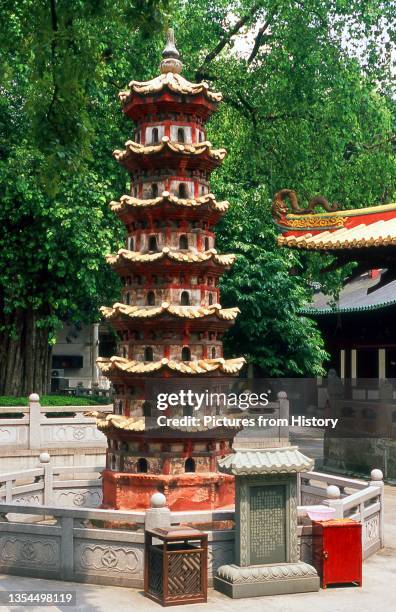
Guangxiao Temple.
Planning Your Visit: A Practical Guide
Best Time to Visit
Guangxiao Temple is open year-round, making it a versatile destination in any season. However, if you want to avoid crowds, consider visiting during weekdays, especially in the early morning when the temple opens at 8:30 AM. The tranquility of the temple in the morning allows for a more reflective experience. Major festivals and public holidays can attract thousands of visitors, so plan accordingly if you’d like a quieter visit.
Recommended Itinerary
For a fulfilling visit to Guangxiao Temple, allocate about 1 to 2 hours. Here’s a suggested itinerary to help you make the most of your time:
- Arrival: Purchase your ticket (5 CNY) and consider buying fresh flowers for offerings.
- Hall of Heavenly Kings: Start your journey here, admiring the Maitreya Buddha and the Four Heavenly Kings.
- Mahavira Hall: Move on to this sacred space to witness the impressive statues of Shakyamuni Buddha and his companions.
- Hair-Burial Pagoda: Engage in the ritual of walking around the pagoda for spiritual purification.
- Explore Additional Halls: Visit Ksitigarbha Hall, Guanyin Hall, and the Sixth Patriarch Hall for more beautiful architecture and spiritual significance.
- Lotus Pond: Take a peaceful stroll around the pond, enjoying the serene atmosphere.
- Exit and Enjoy Local Cuisine: After your visit, indulge in delicious local dishes at nearby restaurants.
Photography Tips
While capturing the beauty of Guangxiao Temple, keep the following tips in mind:
- Respectful Photography: Always be respectful of the sacred environment. Avoid taking photos of Buddha statues and shrine offerings, as this is generally prohibited.
- Golden Hour: For the best lighting, visit during the golden hours—early morning or late afternoon. The warm light will enhance the intricate details of the temple’s architecture.
- Capture the Details: Focus on the unique features of the temple, such as the carvings, inscriptions, and the beautiful bodhi tree. These details tell a story of the temple’s rich history.
What to Wear
Dress modestly to respect the sanctity of the temple. Here are some suggestions:
- Comfortable Footwear: Wear shoes that are easy to remove, as you may need to take them off in certain areas.
- Modest Clothing: Opt for long pants or skirts and tops with sleeves. Avoid short skirts, tank tops, or slippers to ensure compliance with the temple’s dress code.
- Weather Considerations: If visiting during rainy seasons, bring an umbrella. In warmer months, lightweight fabrics will help keep you comfortable.
Insider Tips
-
Engage with Local Practices: Take part in the blessing rituals with flowers, which are available from vendors outside the temple. Each hall has specific flowers that correspond to different wishes, enhancing your experience.
-
Timing Your Visit: If possible, plan your visit on a weekday morning. Not only will you avoid the crowds, but you’ll also witness local devotees engaging in their spiritual practices, offering a deeper cultural insight.
-
Stay Hydrated and Snack Prepared: Though there are food options nearby, it’s wise to carry a bottle of water and a light snack, especially if you’re visiting during the hotter months.
-
Use the QR Codes: Upon arrival, scan the QR codes for maps and detailed information about the temple. This can help enhance your experience and allow for a more in-depth understanding of the various attractions.
-
Be Patient: The temple can be busy, especially during festivals. Embrace the atmosphere and take your time exploring each hall and its offerings. A slower pace allows for meaningful encounters with the temple’s spiritual essence.
By following this practical guide, you’ll be well-prepared to enjoy a memorable visit to Guangxiao Temple, immersing yourself in its rich heritage and spiritual tranquility.
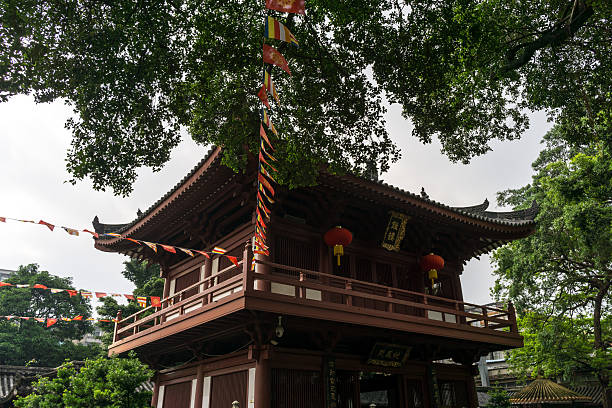
Guangxiao Temple.
Tickets: Prices, Booking, and Tips
When planning your visit to Guangxiao Temple, understanding the ticketing process and options available can enhance your experience. Here’s a comprehensive overview of ticket prices, booking information, and some helpful tips to make your visit as smooth as possible.
| Ticket Type | Price (CNY) | Includes |
|---|---|---|
| Adult Admission | 5 | Access to all temple areas |
| Free Admission | 0 | Children under 1.3 meters & seniors over 60 |
How to Book Your Tickets
Booking your tickets for Guangxiao Temple is straightforward. You have two options:
-
Online Booking: Tickets can be purchased via the official WeChat account or designated booking platforms. This option is convenient and ensures you have your tickets secured before your visit.
-
On-Site Purchase: You can also buy tickets at the on-site ticket office or by scanning the QR code at the entrance. However, given the temple’s popularity, especially during weekends and holidays, it’s advisable to book in advance to avoid long lines and potential disappointment.
Tips for Your Visit
-
Plan Ahead: While the ticket price is modest, the temple can get crowded. Visiting during off-peak hours or weekdays is recommended for a more serene experience.
-
Dress Modestly: To show respect in this sacred space, be sure to dress appropriately—avoid short skirts, tank tops, and slippers.
-
Photography Rules: Remember that photography of Buddha statues is prohibited inside the temple. Maintaining a quiet atmosphere enhances the spiritual experience for all visitors.
-
Bring Flowers for Offerings: If you wish to participate in the temple’s blessing rituals, consider purchasing fresh flowers from nearby vendors. Different halls have specific flower recommendations to maximize your blessings.
By understanding the ticketing process and planning your visit, you can ensure a fulfilling experience at Guangxiao Temple, where history and spirituality intertwine beautifully. Enjoy your journey through this cultural gem of Guangzhou!
How to Get There: A Complete Transportation Guide
From the Nearest Major City
Getting to Guangzhou from Hong Kong
If you’re starting your journey from Hong Kong, you have a couple of convenient options. The most popular is taking the High-Speed Train from Hong Kong West Kowloon Station to Guangzhou South Station. The journey takes about 48 minutes and costs around HKD 250-300. From Guangzhou South Station, you can hop on Metro Line 2 towards Jiangnanxi and transfer to Line 1 at Gongyuanqian Station to reach Guangxiao Temple.
Alternatively, you can take a long-distance bus from various locations in Hong Kong to Guangzhou. This option takes approximately 3-4 hours and generally costs between HKD 150-200. Buses typically arrive at various stations in Guangzhou, with Tianhe Bus Station being a common drop-off point. From there, you can take a taxi or use the metro to get to the temple.
Traveling from Guangzhou Baiyun Airport
If you’re arriving by air, Guangzhou Baiyun International Airport is your point of entry. The airport is around 30 kilometers from Guangxiao Temple. You have several transport options:
-
Taxi: The most direct option, taking about 40-60 minutes, depending on traffic. Expect to pay around CNY 100-150.
-
Airport Shuttle Bus: Take the shuttle bus to Tianhe District and transfer to the metro. The whole trip will take about 1.5 hours and costs about CNY 30.
-
Metro: The airport has a metro line (Line 3) that connects to Tiyu Xilu Station. From there, switch to Line 1 towards Xilang and get off at Gongyuanqian Station. The entire journey takes about 1-1.5 hours and costs approximately CNY 8.
Getting to Guangxiao Temple
From Downtown Guangzhou
Guangxiao Temple is conveniently located in the Yuexiu District, making it easily accessible from various parts of the city.
-
By Metro: The most efficient way to reach Guangxiao Temple is via the Guangzhou Metro. Take Line 1 (the red line) and get off at Gongyuanqian Station. From Exit A, it’s about a 10-minute walk to the temple. Follow the signs for Guangxiao Road.
-
By Bus: Several bus routes serve the area around Guangxiao Temple. You can take bus numbers 19, 55, 113, 182, and 183, all of which stop nearby. Bus fares are around CNY 2-5, depending on your starting point.
-
By Taxi: If you prefer a more direct route, taxis are readily available throughout the city. A ride from central locations like Beijing Road or Yuexiu Park should cost around CNY 20-40, depending on traffic.
Getting Around the Scenic Area
Once you arrive at Guangxiao Temple, the area is pedestrian-friendly, allowing you to explore comfortably on foot. Here are some tips for navigating the temple complex:
-
Walking Route: The recommended walking route inside Guangxiao Temple allows you to visit all the main attractions without doubling back. Start at the Hall of Heavenly Kings, then proceed to the Mahavira Hall, and continue through the various halls and pagodas.
-
Signage: The temple complex is well-marked with signs in both Chinese and English, making it easy to find your way around.
-
Guided Tours: If you want to dive deeper into the temple’s history, consider joining a guided tour. Local tour guides are often available at the entrance and can provide insightful information about the temple’s significance and architectural features.
-
Amenities: There are rest areas and refreshment stalls throughout the temple, where you can take a break and enjoy local snacks.
With this comprehensive transportation guide, you’re well-equipped to visit Guangxiao Temple and immerse yourself in the rich history and serene atmosphere of this cultural gem in Guangzhou. Happy travels!
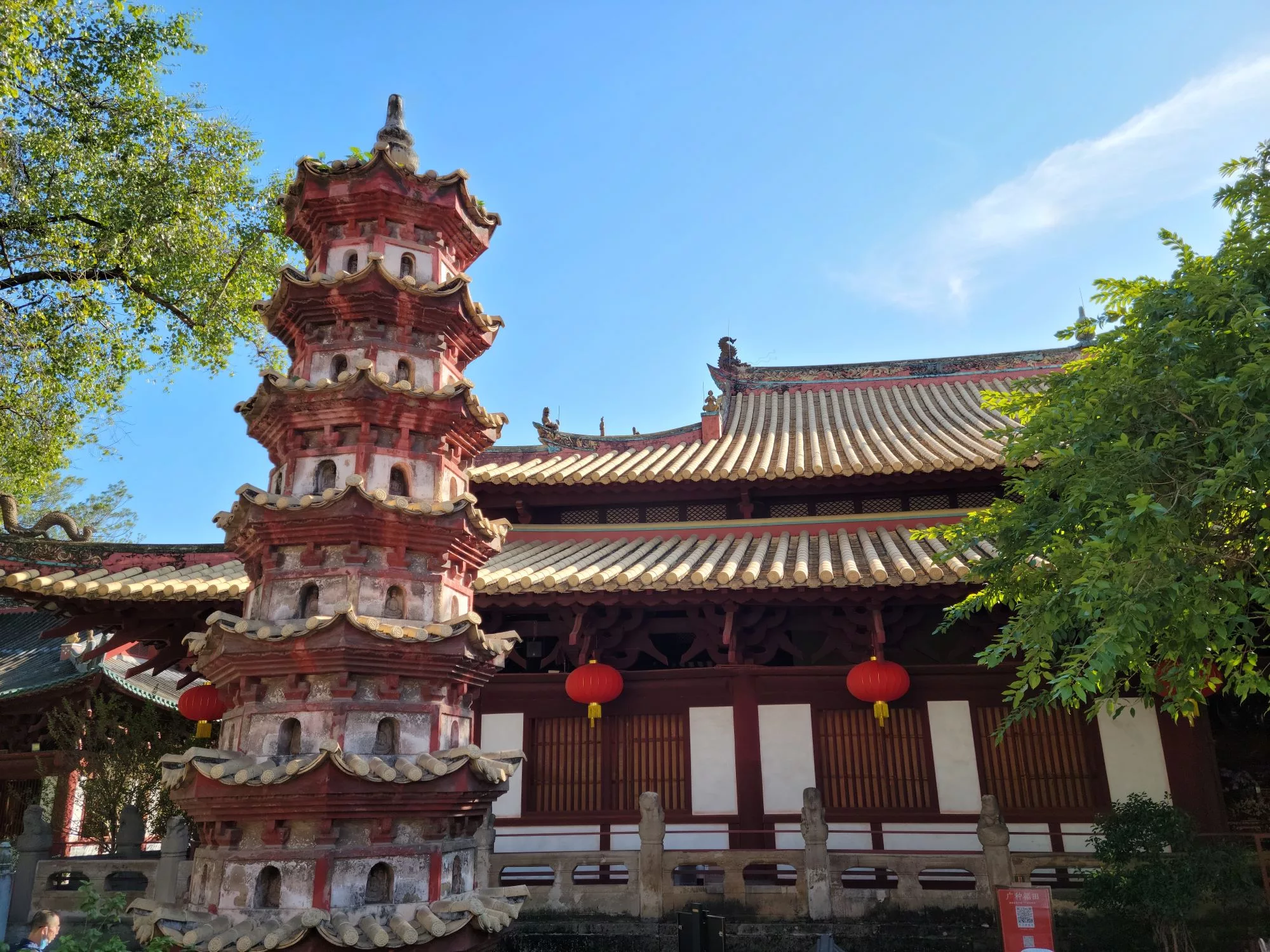
Guangxiao Temple.
Local Cuisine and Accommodation Nearby
When visiting Guangxiao Temple, not only can you immerse yourself in rich history and spiritual tranquility, but you also have the opportunity to savor the delightful local cuisine and find a comfortable place to stay nearby. Here’s a curated selection of restaurants and accommodations that will enhance your experience in Guangzhou.
Culinary Delights Near Guangxiao Temple
- Rongsheng (Guangxiao Road Branch)
- Must-Try Dishes: Known for its sizzling clay pot dishes, the Clay Pot Rice is a local favorite. This dish features perfectly cooked rice topped with a variety of meats and vegetables, allowing the flavors to meld beautifully. Don’t miss the signature Sizzling Pork Belly, which is both crispy and tender.
- Address: 62 Guangxiao Road, Yuexiu District, Guangzhou
- Hours: Daily, 11:00 AM – 2:00 PM and 5:00 PM – 10:00 PM
-
Average Cost: 58 CNY per person
-
Deji Shunde Cuisine (Guangxiao Road Branch)
- Must-Try Dishes: This restaurant excels in Shunde-style dishes, particularly the Sizzling Iron Plate Fish, which is succulent and served with a savory sauce. The Clay Pot Rice with Crispy Rice Crust is also a highlight, offering a delightful crunch paired with flavorful ingredients.
- Address: 51 Guangxiao Road, Yuexiu District, Guangzhou
- Hours: Daily, 10:00 AM – 10:00 PM
-
Average Cost: 30 CNY per person
-
Guangzhou Dim Sum House
- Must-Try Dishes: No visit to Guangzhou is complete without indulging in dim sum. Try the Shrimp Dumplings (Har Gao), which are delicate and bursting with flavor, or the Pork Buns (Char Siu Bao), famous for their fluffy texture and sweet barbecue filling. Pair your meal with a refreshing cup of Jasmine Tea for an authentic experience.
- Address: Near the temple entrance, follow the signs for popular dim sum spots.
- Hours: Daily, 7:00 AM – 10:00 PM
- Average Cost: 40 CNY per person
Places to Stay Near Guangxiao Temple
When it comes to lodging, you have several options to suit your needs, whether you seek luxury, boutique charm, or budget-friendly comfort.
Luxury Accommodation
Sofitel Guangzhou Sunrich
– Location: Approximately 15 minutes by taxi from Guangxiao Temple.
– Price Range: 1,200 RMB and up.
– Special Amenities: Offers a luxurious spa, fine dining restaurants, and an exquisite rooftop bar with panoramic views of the city. Perfect for travelers looking for a lavish experience.
– Highlight: The hotel’s central location makes it easy to explore other attractions in Guangzhou.
Boutique Option
Ying Shang Hotel (Guangzhou Beijing Road Pedestrian Street)
– Location: 9 minutes walk from Yuanquian Metro Station.
– Price Range: 350 RMB.
– Special Amenities: Features a gym, laundry facilities, and robot room service for a unique touch.
– Highlight: Positioned in a quiet area yet close to vibrant attractions, this hotel offers a cozy atmosphere with immaculate service.
Budget Accommodation
CityNote Sino Hotel (Guangzhou Beijing Road Memorial Hall Metro Station)
– Location: 5-minute walk to Memorial Hall Metro Station.
– Price Range: 349 RMB.
– Special Amenities: Provides comfortable rooms equipped with all necessary amenities and access to late-night porridge.
– Highlight: Ideal for budget-conscious travelers who want easy access to public transport and local attractions without sacrificing comfort.
With these dining and accommodation options, you can create a memorable experience during your visit to Guangxiao Temple, fully immersing yourself in the local culture and cuisine. Enjoy your journey through the heart of Guangzhou!
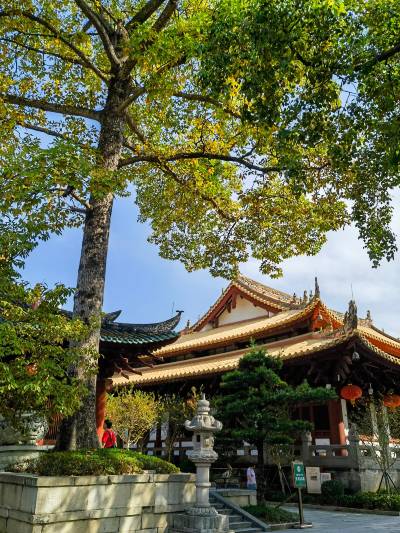
Guangxiao Temple.
Frequently Asked Questions
-
Is Guangxiao Temple suitable for children and the elderly?
Yes, Guangxiao Temple is a family-friendly destination that is accessible to children and the elderly. The temple’s paths are generally flat and easy to navigate. However, it’s advisable to keep a close eye on younger children, especially in crowded areas, and ensure that elderly visitors take their time as they explore the various halls and attractions. -
Are there English signs and guides available?
While the primary language is Chinese, many signs within Guangxiao Temple are bilingual, featuring English translations. Additionally, the temple staff are familiar with basic English phrases and can assist visitors with directions and information. Consider downloading a translation app for more in-depth communication. -
How much time should I plan to spend at Guangxiao Temple?
A visit to Guangxiao Temple typically takes between 1 to 2 hours, depending on your level of interest in the historical and cultural aspects of the site. If you plan to participate in blessings or rituals, or if you enjoy photography, you may want to allocate additional time to fully appreciate the temple’s offerings. -
What are the opening hours for Guangxiao Temple?
Guangxiao Temple is open daily from 8:30 AM to 4:30 PM. It’s best to arrive early to avoid crowds, especially on weekends and public holidays when the temple draws many visitors. -
Is there an entrance fee?
Yes, the entrance fee for Guangxiao Temple is 5 CNY for adults. Admission is free for children under 1.3 meters in height and seniors aged 60 and above. Tickets can be purchased at the entrance or through designated online platforms. -
What should I wear when visiting Guangxiao Temple?
Visitors are encouraged to dress modestly and respectfully. It’s advisable to avoid short skirts, tank tops, and slippers. Comfortable shoes are recommended, as you may be walking quite a bit and need to navigate various halls and outdoor areas. -
Are there facilities for food and rest nearby?
Yes, there are numerous dining options near Guangxiao Temple, ranging from local eateries to more upscale restaurants. Popular spots include Rongsheng and Deji Shunde Cuisine, known for their delicious clay pot dishes. Additionally, there are plenty of rest areas within the temple grounds where you can sit and reflect. -
Can I take photographs inside the temple?
Photography is allowed in most areas of Guangxiao Temple; however, please be respectful and refrain from taking photos of Buddha statues and inside the main halls. It’s also crucial to maintain a quiet atmosphere to honor the sacred nature of the site as many visitors come for reflection and prayer.
Final Thoughts on Your Trip
As your journey through Guangxiao Temple draws to a close, you may find yourself reflecting on the rich tapestry of history, spirituality, and culture that this sacred space embodies. With its intricate architecture, ancient relics, and serene atmosphere, Guangxiao Temple offers a glimpse into the profound wisdom of Buddhist traditions and the enduring spirit of the Lingnan region.
Whether you came seeking blessings at the Hair-Burial Pagoda, found solace in the tranquility of the Bodhi tree, or simply enjoyed the beauty of the temple’s halls, each moment spent here is a reminder of the connection between past and present. As you step back into the vibrant streets of Guangzhou, carry with you a sense of peace and a deeper appreciation for the stories that shape our world.
Remember, traveling is not merely about the places you visit but the experiences that enrich your soul. So, whether you’re lighting incense, sharing a meal nearby, or exploring the local culture, embrace the journey ahead with an open heart and a curious spirit. Your adventure in Guangzhou is just beginning, and the memories you create will linger long after you leave this enchanting city. Safe travels!